Por favor, use este identificador para citar o enlazar a este item:
http://hdl.handle.net/10261/339451COMPARTIR / EXPORTAR:
 SHARE SHARE
 CORE
BASE CORE
BASE
|
|
| Visualizar otros formatos: MARC | Dublin Core | RDF | ORE | MODS | METS | DIDL | DATACITE | |

| Título: | Direct Collocation Methods for Trajectory Optimization in Constrained Robotic Systems |
Autor: | Bordalba, Ricard CSIC ORCID; Schoels, Tobias; Ros, Lluís CSIC ORCID ; Porta, Josep M. CSIC ORCID ; Diehl, Moritz | Palabras clave: | Constrained system Direct collocation Holono- mic constraints Local coordintes Motion planning Nonholonomic constraints Trajectory optimization |
Fecha de publicación: | 2023 | Editor: | Institute of Electrical and Electronics Engineers | Citación: | IEEE Transactions on Robotics 39: 183-202 (2023) | Resumen: | Direct collocation methods are powerful tools to solve trajectory optimization problems in robotics. While their resulting trajectories tend to be dynamically accurate, they may also present large kinematic errors in the case of constrained mechanical systems, i.e., those whose state coordinates are subject to holonomic or nonholonomic constraints, such as loop-closure or rolling-contact constraints. These constraints confine the robot trajectories to an implicitly-defined manifold, which complicates the computation of accurate solutions. Discretization errors inherent to the transcription of the problem easily make the trajectories drift away from this manifold, which results in physically inconsistent motions that are difficult to track with a controller. This article reviews existing methods to deal with this problem and proposes new ones to overcome their limitations. Current approaches either disregard the kinematic constraints (which leads to drift accumulation) or modify the system dynamics to keep the trajectory close to the manifold (which adds artificial forces or energy dissipation to the system). The methods we propose, in contrast, achieve full drift elimination on the discrete trajectory, or even along the continuous one, without artificial modifications of the system dynamics. We illustrate and compare the methods using various examples of different complexity. | Versión del editor: | http://dx.doi.org/10.1109/TRO.2022.3193776 | URI: | http://hdl.handle.net/10261/339451 | DOI: | 10.1109/TRO.2022.3193776 | Identificadores: | doi: 10.1109/TRO.2022.3193776 e-issn: 1941-0468 issn: 1552-3098 |
| Aparece en las colecciones: | (IRII) Artículos |
Ficheros en este ítem:
| Fichero | Descripción | Tamaño | Formato | |
|---|---|---|---|---|
| sci-25-r23-trajopt.pdf | 3,32 MB | Adobe PDF |  Visualizar/Abrir |
CORE Recommender
Page view(s)
34
checked on 16-may-2024
Download(s)
52
checked on 16-may-2024
Google ScholarTM
Check
Altmetric
Altmetric
NOTA: Los ítems de Digital.CSIC están protegidos por copyright, con todos los derechos reservados, a menos que se indique lo contrario.
